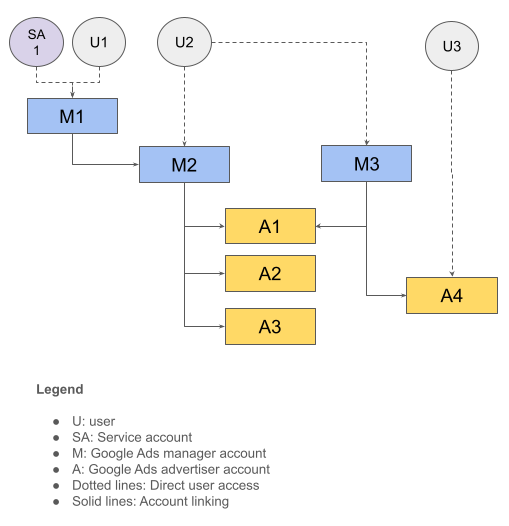Google Ads 帳戶有兩種:Google Ads 管理員帳戶和 Google Ads 廣告主帳戶 (也稱為客戶帳戶)。管理員帳戶可以管理其他 Google Ads 管理員帳戶或 Google Ads 廣告主帳戶。您可以將廣告主帳戶連結至管理員帳戶,然後透過管理員帳戶管理廣告主帳戶。整體連結結構是有向非循環圖,廣告主帳戶位於分葉層級。
您可以授予個別使用者或服務帳戶 Google Ads 帳戶的存取權。您可以透過下列兩種方式,授與使用者廣告主帳戶存取權:
邀請使用者管理帳戶時,您也可以指派使用者角色。
請參考下列帳戶階層。假設所有使用者都具有標準存取權。

下表概略說明這個帳戶結構。
| 使用者 | 可直接存取 | 可間接存取 |
|---|---|---|
| U1、SA1 | M1 | M2、A1、A2、A3 |
| U2 | M2、M3 | A1、A2、A3、A4 |
| U3 | A4 |
登入客戶 ID
使用者可能可以存取多個帳戶階層。在這種情況下發出 API 呼叫時,您需要指定要使用的根帳戶,才能正確判斷授權和帳戶存取層級。方法是在 API 要求中指定 login-customer-id 標頭。
下表使用先前的範例中的帳戶階層,說明您可以使用的登入客戶 ID,以及可呼叫的對應帳戶清單。
| 使用者 | 登入客戶 ID 即可使用 | 用於發出 API 呼叫的帳戶 |
|---|---|---|
| U1、SA1 | M1 | M1、M2、A1、A2、A3 |
| U2 | M2 | M2、A1、A2、A3 |
| U2 | M3 | M3、A1、A4 |
| U3 | A4 | A4 |
如果使用者可直接存取您要呼叫的 Google Ads 帳戶,則可略過提供 login-customer-id 標頭。舉例來說,使用 U3 憑證呼叫 A4 時,您不需要指定 login-customer-id 標頭,因為 Google Ads 伺服器可以從客戶 ID (A4) 正確判斷存取層級。
如果您使用我們的用戶端程式庫,請使用下列設定指定 login-customer-id 標頭。
Java
在 ads.properties 檔案中新增下列設定。
api.googleads.loginCustomerId=INSERT_LOGIN_CUSTOMER_ID_HERE
C#
初始化 GoogleAdsConfig 物件時新增下列設定,並使用該物件建立 GoogleAdsClient 物件。
GoogleAdsConfig config = new GoogleAdsConfig()
{
...
LoginCustomerId = ******
};
GoogleAdsClient client = new GoogleAdsClient(config);
PHP
在 google_ads_php.ini 檔案中新增下列設定。
[GOOGLE_ADS]
loginCustomerId = "INSERT_LOGIN_CUSTOMER_ID_HERE"
Python
在 google-ads.yaml 檔案中新增下列設定。
login_customer_id: INSERT_LOGIN_CUSTOMER_ID_HERE
Ruby
在 google_ads_config.rb 檔案中新增下列設定。
Google::Ads::GoogleAds::Config.new do |c|
c.login_customer_id = 'INSERT_LOGIN_CUSTOMER_ID_HERE'
end
傳遞儲存這個檔案的路徑,建立 GoogleAdsClient 執行個體。
client = Google::Ads::GoogleAds::GoogleAdsClient.new('path/to/google_ads_config.rb')
Perl
在 googleads.properties 檔案中新增下列設定。
loginCustomerId=INSERT_LOGIN_CUSTOMER_ID_HERE
curl
執行 curl 指令時,請指定下列指令列引數。
-H "login-customer-id: LOGIN_CUSTOMER_ID"
您可以使用 CustomerService.ListAccessibleCustomers 方法,擷取使用者可直接存取的帳戶清單。這些帳戶可用做 login-customer-id 標頭的有效值。
Java
private void runExample(GoogleAdsClient client) { // Optional: Change credentials to use a different refresh token, to retrieve customers // available for a specific user. // // UserCredentials credentials = // UserCredentials.newBuilder() // .setClientId("INSERT_OAUTH_CLIENT_ID") // .setClientSecret("INSERT_OAUTH_CLIENT_SECRET") // .setRefreshToken("INSERT_REFRESH_TOKEN") // .build(); // // client = client.toBuilder().setCredentials(credentials).build(); try (CustomerServiceClient customerService = client.getLatestVersion().createCustomerServiceClient()) { ListAccessibleCustomersResponse response = customerService.listAccessibleCustomers( ListAccessibleCustomersRequest.newBuilder().build()); System.out.printf("Total results: %d%n", response.getResourceNamesCount()); for (String customerResourceName : response.getResourceNamesList()) { System.out.printf("Customer resource name: %s%n", customerResourceName); } } }
C#
public void Run(GoogleAdsClient client) { // Get the CustomerService. CustomerServiceClient customerService = client.GetService(Services.V22.CustomerService); try { // Retrieve the list of customer resources. string[] customerResourceNames = customerService.ListAccessibleCustomers(); // Display the result. foreach (string customerResourceName in customerResourceNames) { Console.WriteLine( $"Found customer with resource name = '{customerResourceName}'."); } } catch (GoogleAdsException e) { Console.WriteLine("Failure:"); Console.WriteLine($"Message: {e.Message}"); Console.WriteLine($"Failure: {e.Failure}"); Console.WriteLine($"Request ID: {e.RequestId}"); throw; } }
PHP
public static function runExample(GoogleAdsClient $googleAdsClient) { $customerServiceClient = $googleAdsClient->getCustomerServiceClient(); // Issues a request for listing all accessible customers. $accessibleCustomers = $customerServiceClient->listAccessibleCustomers(new ListAccessibleCustomersRequest()); print 'Total results: ' . count($accessibleCustomers->getResourceNames()) . PHP_EOL; // Iterates over all accessible customers' resource names and prints them. foreach ($accessibleCustomers->getResourceNames() as $resourceName) { /** @var string $resourceName */ printf("Customer resource name: '%s'%s", $resourceName, PHP_EOL); } }
Python
def main(client: GoogleAdsClient) -> None: customer_service: CustomerServiceClient = client.get_service( "CustomerService" ) accessible_customers: ListAccessibleCustomersResponse = ( customer_service.list_accessible_customers() ) result_total: int = len(accessible_customers.resource_names) print(f"Total results: {result_total}") resource_names: List[str] = accessible_customers.resource_names for resource_name in resource_names: # resource_name is implicitly str print(f'Customer resource name: "{resource_name}"')
Ruby
def list_accessible_customers() # GoogleAdsClient will read a config file from # ENV['HOME']/google_ads_config.rb when called without parameters client = Google::Ads::GoogleAds::GoogleAdsClient.new accessible_customers = client.service.customer.list_accessible_customers().resource_names accessible_customers.each do |resource_name| puts "Customer resource name: #{resource_name}" end end
Perl
sub list_accessible_customers { my ($api_client) = @_; my $list_accessible_customers_response = $api_client->CustomerService()->list_accessible_customers(); printf "Total results: %d.\n", scalar @{$list_accessible_customers_response->{resourceNames}}; foreach my $resource_name (@{$list_accessible_customers_response->{resourceNames}}) { printf "Customer resource name: '%s'.\n", $resource_name; } return 1; }
curl
# Returns the resource names of customers directly accessible by the user # authenticating the call. # # Variables: # API_VERSION, # DEVELOPER_TOKEN, # OAUTH2_ACCESS_TOKEN: # See https://developers.google.com/google-ads/api/rest/auth#request_headers # for details. # curl -f --request GET \ "https://googleads.googleapis.com/v${API_VERSION}/customers:listAccessibleCustomers" \ --header "Content-Type: application/json" \ --header "developer-token: ${DEVELOPER_TOKEN}" \ --header "Authorization: Bearer ${OAUTH2_ACCESS_TOKEN}" \
如果 ListAccessibleCustomers 方法無法擷取客戶 ID,該怎麼辦?
如果 CustomerService.ListAccessibleCustomers 方法未擷取您預期會顯示在結果中的客戶 ID,可能原因如下。
您有權存取客戶 ID,但存取權是透過上層管理員帳戶核發。舉例來說,如果您在先前的範例中,使用使用者
U1憑證呼叫ListAccessibleCustomers方法,即使U1有權存取更多帳戶,結果中也只會傳回M1。如要確認這種可能性,請為ListAccessibleCustomers方法傳回的每個帳戶擷取帳戶階層。如要這麼做,請按照上一節所述,將每個帳戶設為登入客戶 ID。如果您有權存取目標帳戶,應該就能在其中一個帳戶階層中擷取該帳戶。您使用的 OAuth 憑證不正確。最常見的情況是您使用其他使用者的憑證。舉例來說,可能是因為不小心將沙箱或開發人員憑證與正式版憑證混用,或是從資料庫或本機快取中錯誤讀取其他使用者的憑證。如要排解這項問題,其中一個方法是使用 Google People API 擷取登入使用者的名稱和電子郵件地址,並確認是否與您預期的電子郵件地址相符。
您無權存取該帳戶。請按照操作說明,取得正確客戶帳戶的存取權。
使用者角色
Google Ads API 沒有專屬的存取模式,也不會使用專屬的 OAuth 2.0 範圍來限制功能。舉例來說,Google Ads API 對於唯讀和讀寫作業使用相同的範圍。Google Ads API 採用與 Google Ads 相同的使用者角色。如果是在管理員層級授予帳戶使用者角色,階層中的帳戶就會沿用該角色。如果使用者在特定帳戶中擁有衝突的角色,系統會根據 API 要求中指定的 login-customer-id 帳戶,解決正確的層級。
下表使用上一個範例的帳戶階層,說明授予使用者各種使用者角色後的效果。
| 使用者 | 已授予使用者角色 | login-customer-id | 有效存取層級 |
|---|---|---|---|
| SA1 | 帳戶 M1 的標準存取權 | M1 | M1、M2、A1、A2、A3 的標準存取權 |
| U2 |
M2 的標準存取權 M3 的唯讀存取權 |
M2 | M2、A1、A2、A3 的標準存取權 |
| U2 |
M2 的標準存取權 M3 的唯讀存取權 |
M3 | M3、A1、A4 的唯讀存取權 |

